Physical Address
304 North Cardinal St.
Dorchester Center, MA 02124
Physical Address
304 North Cardinal St.
Dorchester Center, MA 02124
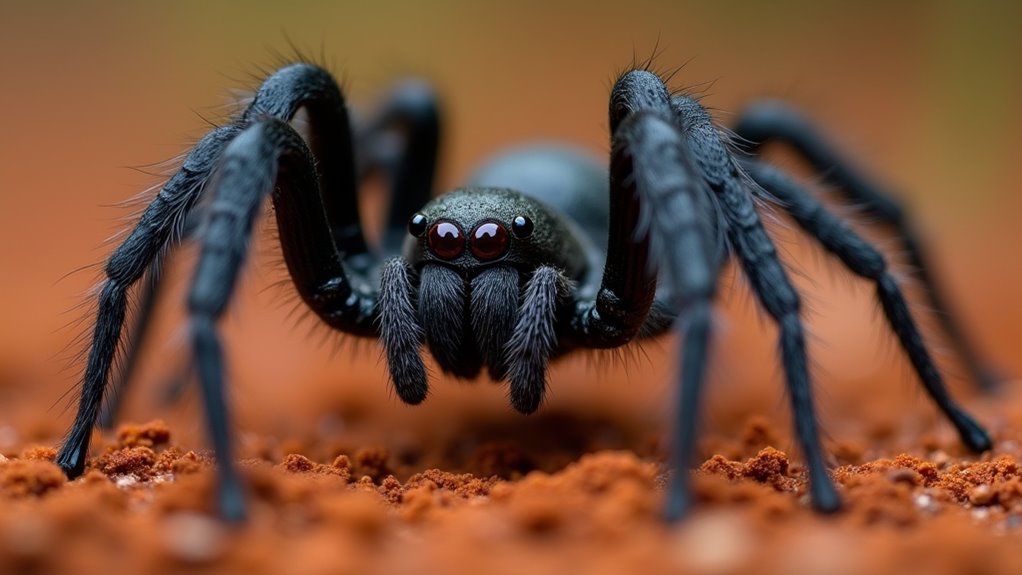
Terror lurks in Australia's corners as deadly spiders hide in unexpected places – which venomous species should you fear most?
Australia hosts several dangerous spiders you should watch for: the iconic Redback, deadly Sydney Funnel-Web, aggressive Mouse Spider, and controversial White-Tailed Spider. Also be wary of Yellow Sac, Trapdoor, Black House, Wolf, and the non-native Recluse spiders. While most aren’t lethal with modern treatment, they can cause significant pain and medical complications. Wear protective clothing in gardens and woodpiles to avoid unwelcome encounters with these eight-legged threats.
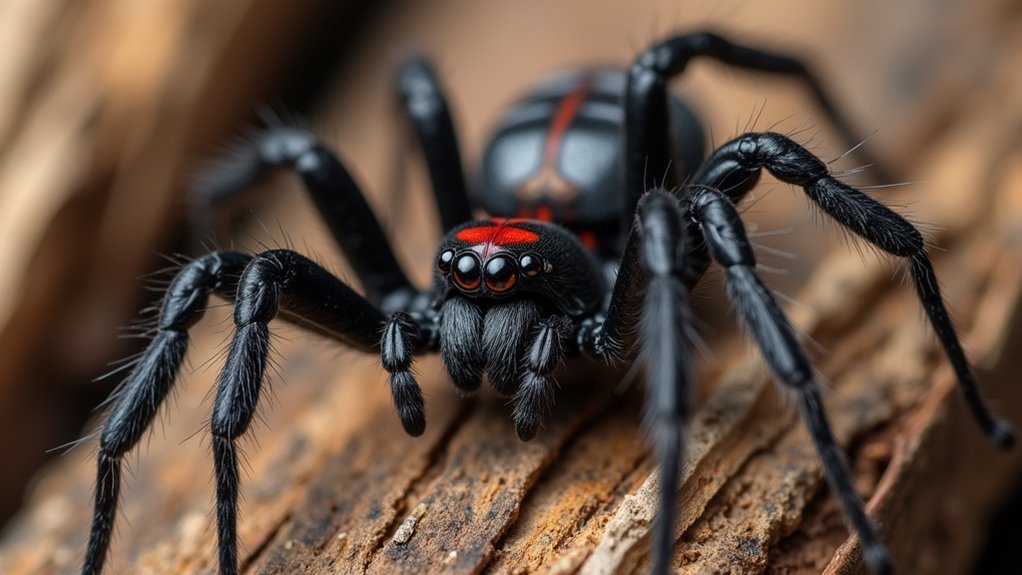
When exploring Australia’s dangerous wildlife, you’ll inevitably encounter the Redback spider, one of the continent’s most recognizable arachnids. This glossy black spider (scientific name Latrodectus hasselti) is easily identified by the distinctive red or orange stripe on the female’s abdomen.
Redbacks prefer living near humans in cluttered areas like sheds, wood piles, and gardens. They’re not typically aggressive but will bite if provoked or trapped. Female Redbacks construct distinctive webs with tangled, funnel-like retreats and vertical sticky threads designed to capture prey effectively.
The female, measuring about 1 cm, poses the greater threat with her potent neurotoxic venom.
Though once responsible for numerous fatalities, no deaths have occurred in Australia for over 50 years thanks to antivenom.
If bitten, you’ll experience severe pain, sweating, nausea, and muscle weakness. Seek immediate medical attention.
Among Australia’s impressive roster of venomous creatures, the Sydney Funnel-web spider (Atrax robustus) is prominent as the continent’s most lethal arachnid. You’ll recognize this fearsome spider by its glossy blue-black to dark-plum body spanning 2-4 cm and leg spread reaching 7 cm.
Native to eastern Australia, particularly around Sydney, these spiders prefer moist environments in closed forests. They’re typically found under logs or foliage from the Central Coast to the Illawarra region and west to the Blue Mountains. When threatened, they display aggressive behavior by rearing up and exposing their fangs.
The Sydney Funnel-web thrives in eastern Australia’s damp forests, lurking beneath vegetation from the Central Coast to the Blue Mountains.
Their venom contains powerful atracotoxins that can be deadly. Before 1981’s antivenom development, they caused numerous fatalities.
While bites are now rare, you should exercise caution in their habitat areas, as they remain medically serious. If considering relocation within Australia, you might want to research affordable places that have lower populations of these dangerous arachnids.
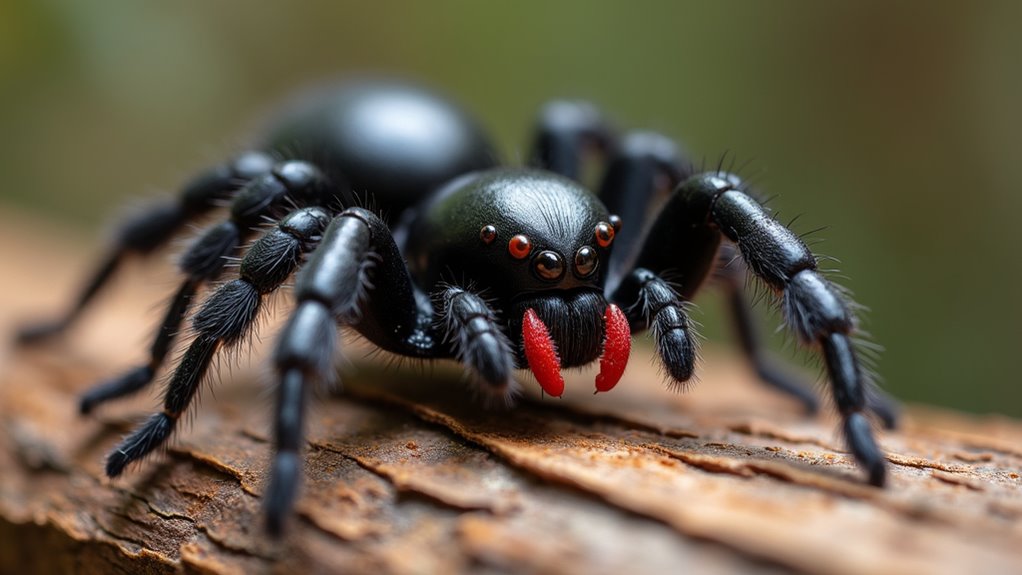
Despite their lesser fame compared to the Sydney Funnel-web, Mouse Spiders represent another highly venomous Australian arachnid that deserves serious attention. These spiders (genus Missulena) have venom potentially as toxic as their funnel-web cousins, though they deliver fewer serious bites.
You’ll recognize Mouse Spiders by their bulbous head and jaw regions, with males displaying vibrant coloration while females are typically larger and darker. Female mouse spiders are notoriously difficult to identify due to their uniform black coloration. Don’t be fooled by their name—they don’t prey on mice, nor do they dig mouse-like burrows.
If bitten, seek medical attention immediately. Fortunately, funnel-web antivenom works effectively against Mouse Spider venom.
While you’ll most commonly encounter males during warmer months, they generally prefer less populated, drier environments throughout Australia. Australia is home to numerous dangerous species that require caution when exploring the outdoors.
Few Australian spiders have generated as much controversy and misinformation as the white-tailed spider. Recognizable by their slender bodies and white-tipped abdomens, these common household visitors are found throughout Australia.
Despite persistent myths, scientific evidence firmly debunks claims that their bites cause necrotic ulcers. The largest study of 130 confirmed bites found no cases of tissue death, with research establishing less than 3% probability of necrosis occurring. Two species are primarily involved: Lampona cylindrata and murina, which are morphologically similar with distinctive white patches.
If bitten, you’ll likely experience only mild pain and a small red mark that resolves within two weeks. No severe reactions or systemic illness have been documented in confirmed cases.
White-tailed spiders are actually beneficial, preying on other household spiders. You’ll most commonly encounter them in bedding or clothing during warmer months. Unlike Australia’s deadly spiders, these arachnids pose minimal risk to travelers, who often prefer exploring New Zealand attractions for their adventure fix without spider concerns.
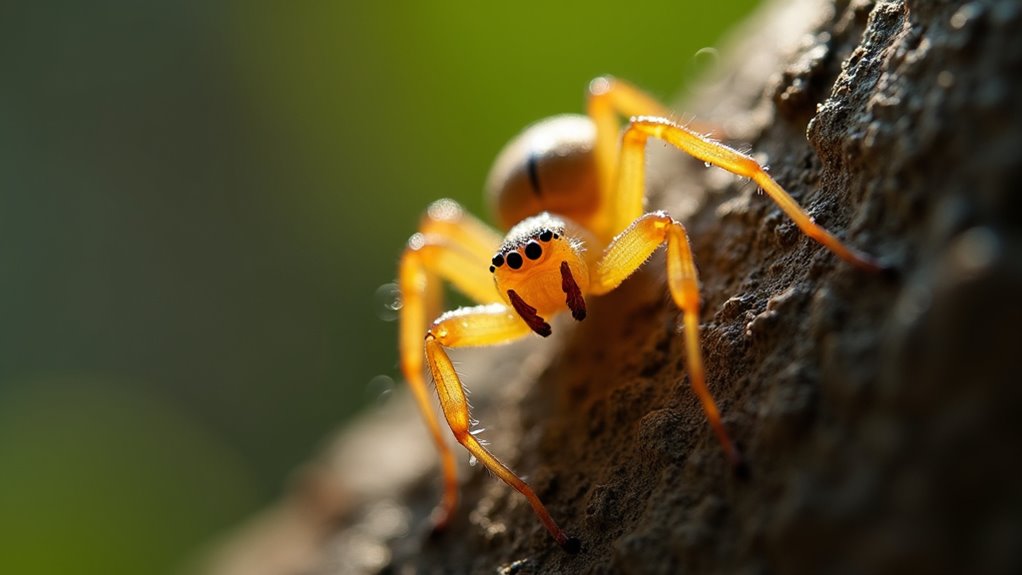
The yellow sac spider may be small in stature, but its potent venom packs a surprising punch. These nickel-sized arachnids are commonly found in Australian homes, particularly during warmer months.
Don’t let their tiny size fool you — yellow sac spiders deliver a venomous bite that belies their diminutive appearance.
You’ll often encounter them in cluttered areas or hiding in clothing.
Their bites can range from painless to feeling like a wasp sting, typically causing redness, swelling, and burning sensations that may persist for up to a week. These spiders are most active during nocturnal habits and tend to hide in their silken sacs during daylight hours.
While rare, their cytotoxic venom can cause necrosis in some cases.
If you experience headache, nausea, or vomiting after a bite, seek medical attention immediately.
To avoid encounters, keep your home tidy, don’t reach into dark spaces, and shake out clothing before wearing.
Apply ice packs to bites for immediate relief.
Many Australians consider these spiders one of the key factors to consider when evaluating the safety of their living environment.
Lurking beneath the soil surface in eastern and southern Australia, trapdoor spiders create elaborate silk-lined burrows that often feature a perfectly camouflaged door. These stocky, brown spiders are commonly found in gardens, lawns, and bushlands across New South Wales, Victoria, and Tasmania.
Though they appear intimidating, trapdoor spiders pose minimal threat to humans. Their venom isn’t life-threatening, and they rarely bite unless provoked. While often confused with the deadly Funnel-web spider, trapdoor spiders are less dangerous and typically cause only local pain and swelling if they bite.
You’ll typically find them active at night when they wait at their burrow entrances to ambush passing insects like crickets and moths. Unlike some other Australian spiders, trapdoor spiders can be found on both the east coast and west coast of Australia, though their species may vary by region.
If you discover a trapdoor spider’s home, it’s best to leave it undisturbed. These shy creatures play an important ecological role by controlling insect populations, despite their fearsome reputation.
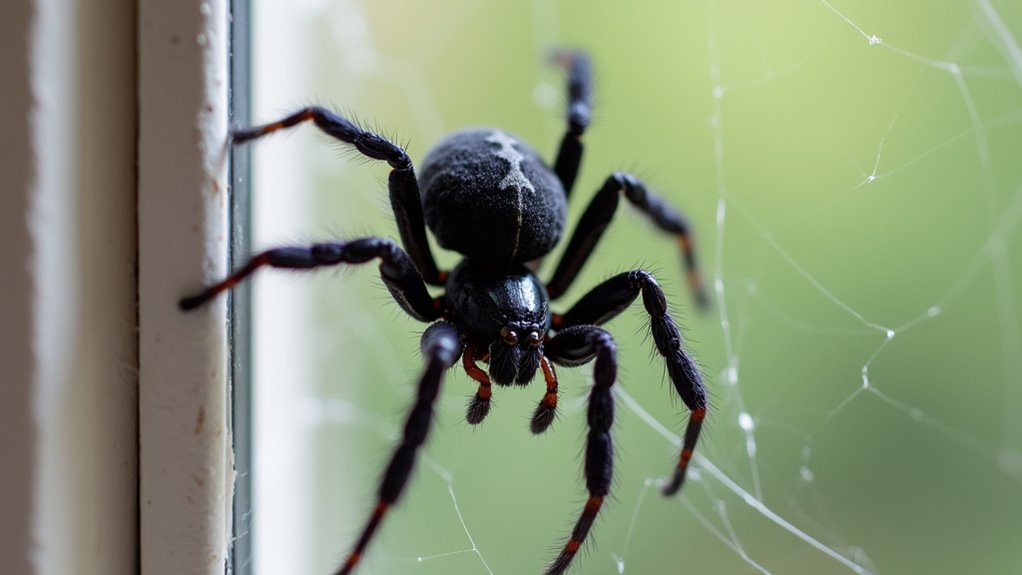
Black house spiders, despite their intimidating name, are among Australia’s most common arachnids in urban environments. You’ll spot their distinctive funnel-shaped webs with irregular edges in window frames, wall crevices, and tree trunks across southern and eastern Australia and New Zealand.
These nocturnal members of the Desidae family construct their sheltered webs in corners of rooms and doorways, often building multiple webs close together. They’re attracted to light sources where insects gather, making your home an ideal hunting ground. Their webs are made from cribellate silk that snags prey rather than using sticky threads.
While venomous, their bites typically cause only minor pain and swelling, not serious harm. They’re generally non-aggressive unless disturbed.
Still, it’s wise to treat them with caution and respect their territory, as they’ve adapted remarkably well to coexisting with humans.
Unlike their web-spinning cousins, wolf spiders are formidable ground hunters you’ll likely encounter in gardens and around your home across Australia. These solitary arachnids don’t spin webs; instead, they create silk-lined burrows and actively chase prey. They’re effective natural pest control by consuming insects like ants, bed bugs, and cockroaches. Unlike New Zealand, which is famously snake free, Australia hosts both venomous spiders and snakes in abundance.
Wolf spiders: Australia’s relentless hunters that chase prey rather than trap it in silky webs.
You’ll recognize them by their distinctive 4-2-2 eye pattern and impressive speed.
If disturbed or handled, wolf spiders will bite, causing:
While not deadly, their bites are certainly unpleasant. Wolf spiders typically flee when they sense your presence, but females carrying egg sacs may act more defensively.
When gardening or moving stored items, wear gloves to avoid accidental encounters with these aggressive hunters.
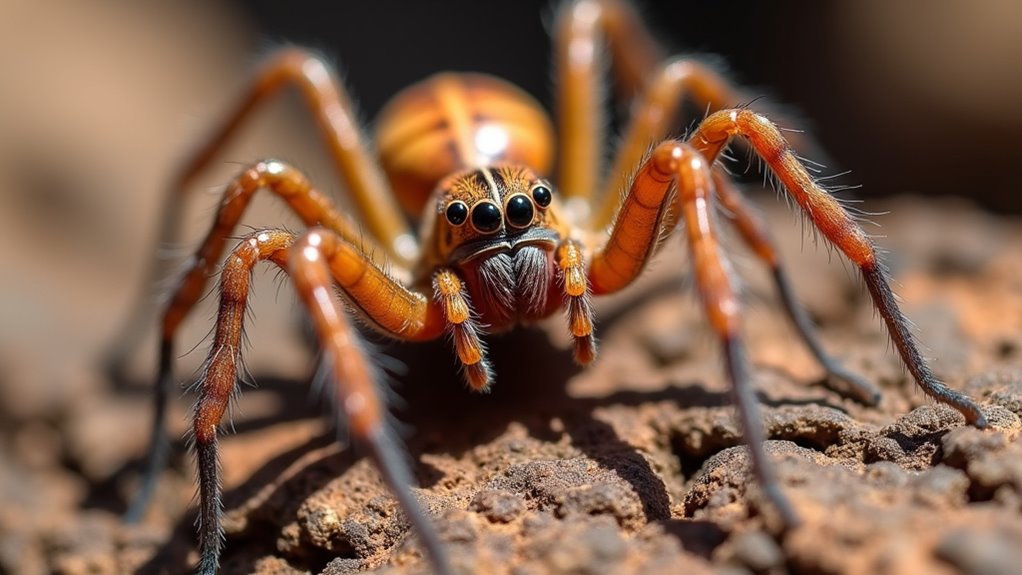
While not native to Australia, recluse spiders have been discovered in isolated cases across the country, particularly in Adelaide. You’ll recognize these newcomers by the distinctive violin-shaped marking on their light brown bodies.
They’re notorious for building irregular webs in dark, secluded areas like woodpiles, sheds, and unheated basements. Travelers coming from Queenstown adventure spots might be surprised to find these spiders in Australian locations, as the environments differ significantly.
Though non-aggressive, recluse spiders will bite when threatened, injecting venom that contains sphingomyelinase D, an enzyme that destroys tissue and can cause painful necrotic lesions and sometimes serious systemic symptoms. If bitten, seek medical attention immediately, as severe cases may require specific antivenom.
Unlike Australia’s native venomous spiders, recluses can survive without food for up to six months and tolerate both hot and cold environments.
While not yet widespread, authorities continue to monitor their population to prevent hotel.
Australia’s deadly spiders demand your respect and awareness. While fatalities are rare these days due to antivenoms, bites can still be serious health emergencies. Remember the 2016 case of a Sydney man who was bitten by a funnel-web in his garden and reached the hospital with just minutes to spare. Keep your garden gloves on, check your shoes, and know the nearest medical facility—it might save your life.